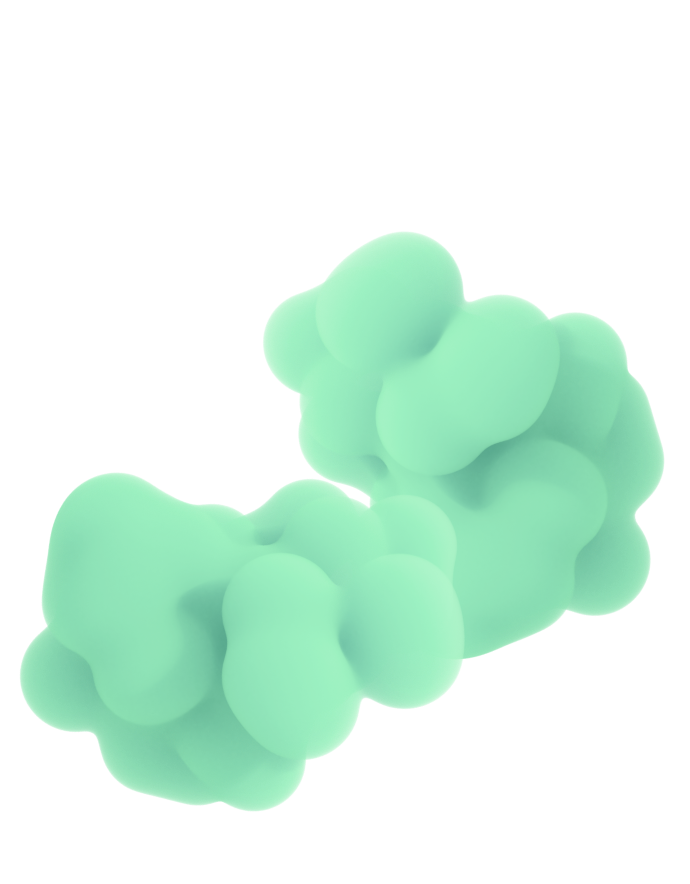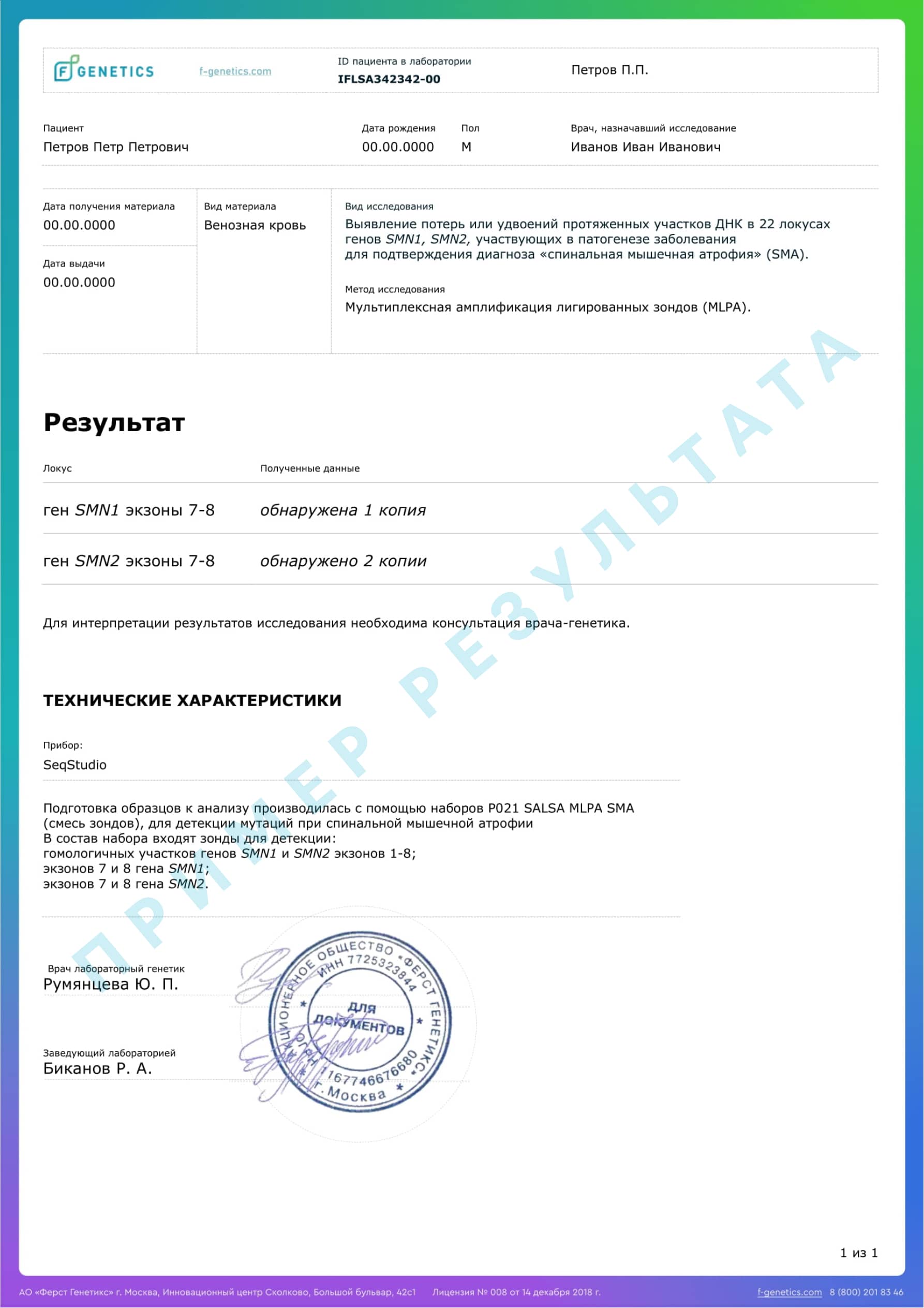Features
An inherited degenerative disease characterised by weakness and wasting (atrophy) of skeletal muscles. Skeletal muscle weakness and wasting (atrophy) is caused by a reduction in the number of certain types of nerve cells called inferior motor neurons that run from the spinal cord to the muscles and allow them to control movement.
Weakness tends to be more pronounced in muscles close to the centre of the body (proximal muscles) compared to those far from the centre of the body (distal muscles). The onset of muscle weakness varies from the prenatal period to adolescence.
Childhood SMA is the most common genetic cause of child mortality. 1.
SMA is usually divided into 4 types depending on the age of onset and the severity of the disease:
Type I
Infant, Werdnig-Hoffmann disease
It is the most common form of the disease. Manifestation occurs at birth or during the first few months of life. Children have impaired motor activity, difficulty breathing, swallowing, and are unable to hold their head and sit up on their own. Most children with type I SMA do not survive to the age of two due to respiratory failure.
Type II
Intermediate, Dubowitz disease
The disease usually manifests itself between 7 and 18 months of age. Children can sit up without support, but cannot stand or walk without help. They often have tremors in their fingers, scoliosis, and weakness of the respiratory muscles, which can be life-threatening. The life expectancy of people with type II SMA varies according to the degree of involvement of the respiratory muscles in the pathological process.
Type III
Adolescent, Kügelberg-Welander disease
Manifestation of the disease occurs after 18 months. Patients can stand and walk without assistance, but are prone to disability. People with type III SMA usually have a normal life expectancy.
Type IV
Adult form
Type IV SMA is rare and begins on average after the age of 35. Patients experience mild to moderate muscle weakness, tremor and shortness of breath. People with type IV SMA have a normal life expectancy.
Pathogenesis
The SMN1 and SMN2genes are key in the development of SMA and contain instructions for the creation of the Survival of motor neuron protein-interacting protein (SMN). The structure of these genes is almost identical; they differ in the sequence of nucleotides in exons 7 and 8.
Most people with spinal muscular atrophy are missing part of the SMN1Most people with spinal muscular atrophy are missing part of the SMN1 gene, which impairs the production of SMN protein. The SMN protein deficiency leads to the death of motor neurons, resulting in signals not being transmitted from the brain to the muscles. This leads to many skeletal muscles becoming weak and depleted, manifesting as the symptoms of SMA described below.
SMN1 and SMN2play a key role in the development of SMA
Number of SMN2 gene copies SMN2
Typically, people have two copies of the SMN1 gene and one to two copies of the SMN2 gene in each cell. However, the number of copies of the SMN2 varies, with up to eight copies found in some people. The number of copies of the SMN2 gene in the absence of SMN1 changes the severity of the condition and helps to determine the type of atrophy that is developing. The more copies of SMN2, the better the patient can make up for the loss of SMN1. All types of SMA are characterised by the absence of part of the SMN1, and the number of SMN2 copies is different for each type.
Type I
have 1 or 2 copies of SMN2
Type III
3-4 copies of SMN2
Type II
3 copies of SMN2
Type IV
4 or more copies of SMN2
Frequency
Spinal muscular atrophy occurs in 1 in 8,000 to 10,000 people worldwide.
Type I
is the most common type, accounting for about half of all cases
Types II & III
less common
Type IV
rare
Type of inheritance
pinal muscular atrophy is inherited in an autosomal recessive patternIn most cases, each parent of a person with autosomal recessive disease carries one copy of the mutated gene. However, because the mutation is compensated for by the presence of a second 'healthy' copy of the gene, carriers do not show signs and symptoms of the disease.
People who have more than two copies of the SMN2 gene do not usually inherit extra copies from a parent. They appear as a result of an inadvertent error during the formation of germ cells (egg or sperm) or immediately after fertilisation. SMN2, обычно не наследуют дополнительные копии от родителя. Возникают они во время случайной ошибки в процессе образования половых клеток (яйцеклетки или сперматозоида) или сразу после оплодотворения.
These risks are approximate, because about 2% of people with SMA have a de novo (spontaneously occurring) variant of SMN1 of one copy. In these cases, only one parent is a carrier and there is no increased risk of developing SMA in subsequent pregnancies. 2.
Features
In 2002, Schouten et al. reported a method of multiplex ligation probe amplification (MLPA). This method was applied to detect the loss or doubling of long stretches of DNA.
MLPA
The most sensitive test for detecting SMA. It can diagnose SMA in 95% of cases.
SMN1 gene sequencing SMN1
For the remaining patients, SMN1 gene sequencing is performed (it is needed when the diagnosis could not be confirmed by MLPA and the patient has clinical manifestations of SMA). Conducted for the remaining 5% of patients.
When neither MPLA nor sequencing is able to find the cause of the clinical symptoms that allow the doctor to suspect SMA or other neuromuscular disease, the doctor may appoint an examination of a panel of genes whose mutations are characteristic for neuromuscular diseases.
Biological samples appropriate for this test:
- Peripheral blood;
- Fetal blood;
- Dried blood spots.
Literature Cited:
1. Arnold ES, Fischbeck KH. Spinal muscular atrophy. Handb Clin Neurol. 2018;148:591-601
2. Cusin V, Clermont O, Gerard B, Chantereau D, et al. Prevalence of SMN1 deletion and duplication in carrier and normal populations: implication for genetic counseling. J Med Genet 2003; 40
3. Kolb et al. Natural history of infantile-onset spinal muscular atrophy. Ann Neurol. 2017 Dec;82(6):883-891
4. Prior et al. Spinal Muscular Atrophy. GeneReviews®. Adam MP, Ardinger HH, Pagon RA, et al., editors. Seattle (WA): University of Washington, Seattle; 1993-2018
5. Schouten JP, McElguun CJ, Waaijer R, Zwijnenburg D, et al. Relative quantification of 40 nucleic acid sequences by multiplex ligation-dependent probe amplification. Nucleic Acids Res 2002; 30: e57.
How do I get a DNA test for SMA?
Give blood (4 mL) in an EDTA tube (with a purple cap)
Be sure to sign each tube!
The courier will pick up the kit with your blood and take it to the lab free of charge .
The advantages at First Genetics
Specialists
Years of experience in genetics, laboratory diagnostics and bioinformatics
Confidentiality
All data is strictly confidential and cannot be passed on to third parties
Security
Extensive control at each stage of testing
Timeframe
Results ready in a short time
Free delivery
Free delivery of biomaterial across Russia
SMA
A test to confirm or refute the diagnosis of spinal muscular atrophy and to clarify the type of disease.
8 (800) 201 83 46



